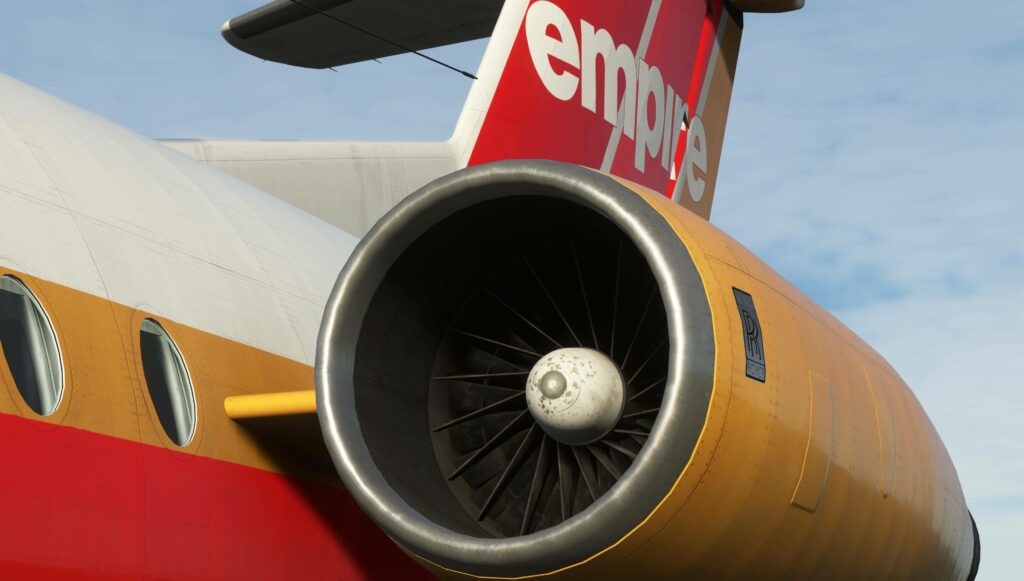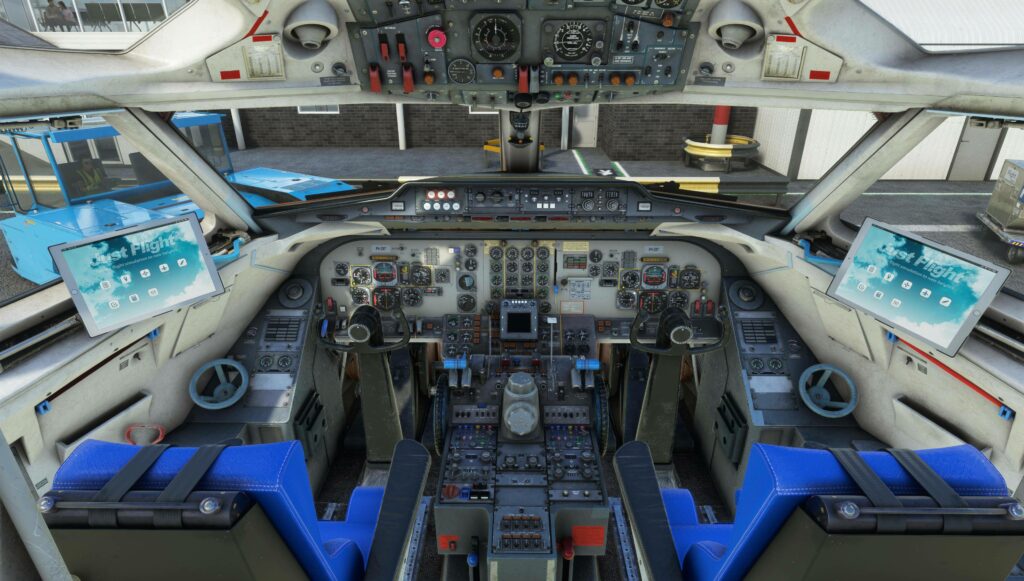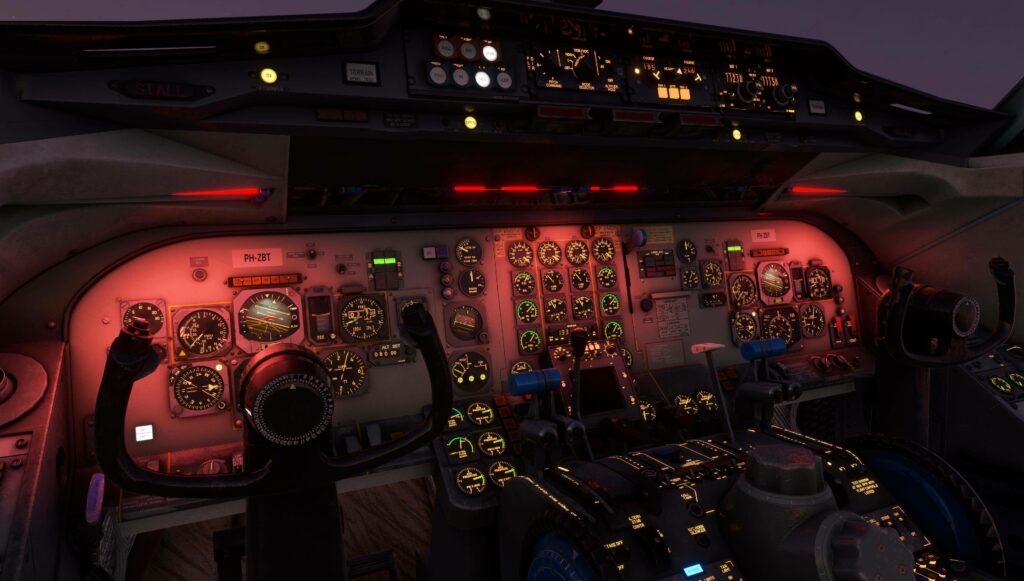Wie angekündigt haben die britischen Add-on-Designer von Just Flight gestern Nachmittag ein weiteres Add-on aus der Vintage-Ecke veröffentlicht. Die Simulation der Fokker F28 steht jetzt zum Download bereit. Die F28 Professional kommt dabei in vier Varianten und verspricht zeitgemäße Systemtiefe.
65 Euro kostet die F28, direkt im Webshop der Briten. Laut Systembeschreibung soll es eine akkurate Umsetzung des kleinen, holländischen Regionaljets sein. Zur Modellierung ist das Team immer wieder nach Holland geflogen und hat die PH-CHN bei Fokker in Woensdrecht als Grundlage genommen.
Im Zuge der Veröffentlichung hat Just Flight bereits eine Tutorial-Serie veröffentlicht, die das Flugzeug in allen Flugphasen zeigt und dabei seine Eigenheiten erklärt. Die Handbücher gibt es auf der Just Flight-Website kostenlos zum Download.
Hier die Features des Add-ons im Detail:
MODEL
- Four variants of the F28 Fellowship are included:
– Mk 1000
– Mk 2000
– Mk 3000
– Mk 4000 - Accurately modelled using real-world aircraft plans and comprehensive photography of the real aircraft, ex-PH-CHN at AM&TS (Curio) Woensdrecht
- Realistic animations, including all passenger, service and cargo doors, jetway-configurable passenger door, control surfaces and mechanisms, distinctive lift dumpers and tail-mounted airbrake
- 4K and 8K textures are used to produce the highest possible texture clarity, with decals used for high-resolution text
- Full support for MSFS visual icing effects and ground services support
- Authentic labelling and placards based on those found in the real aircraft
- Realistic, dynamic wing-flex
- Custom ground equipment (GPU, cones and chocks)
- Optional engine hush kits
- Optional HF antennas
- Detailed external models customised for each F28 variant
- Detailed passenger cabin and galley customised for each F28 variant, with fully functional forward galley controls
COCKPIT
- Captain, Co-Pilot and jump seat positions modelled with every switch, knob and lever animated and functional
- A truly 3D cockpit environment right down to accurately modelled seat belts and screw heads – every instrument is constructed fully in 3D with smooth animations
- Authentic gauges and navigation equipment, including RMI (VOR/ADF) and HSI
- Realistic autopilot system including pitch, roll, altitude and IAS hold modes, and navigation hold mode that can be linked to the MSFS flight plan
- GNS530 GPS navigation option
- Cockpit textures feature wear and tear based on reference photos taken in the real aircraft to produce an authentic environment
- Aircraft configuration system that allows you to choose between ‚cold & dark‘, ‘turnaround’ or ‚ready for take-off‘ save states
- Many features have been added to help with usability, such as the ability to hide the control yokes for a better view of the instruments and pre-set angled views for the overhead and centre pedestal
- Tablet EFB for controlling various aircraft states and options and checking aircraft and flight information, including full Navigraph and simBrief integration
- Developed using the latest MSFS standards, including intuitive and easy-to-use controls for rotary knobs, multi-position switches and levers
- Compatible with MSFS VR mode
- Realistic dimmable lighting from multiple fixed and moveable sources
- Full support for MSFS checklists (manual and automatic/Co-pilot modes)
LIVERIES
The F28 Fellowship comes with with a range of 30 liveries from around the world, reflecting its varied airline service:
Mk 1000
- Air France (F-BUTE)
- Air Ontario (C-FONG)
- Argentine Air Force (T-50)
- Canadian Regional (C-GYCR)
- Demonstrator (PH-MOL)
- Horizon Air (N801PH)
- LTU (D-ABAX)
- Martinair (PH-MAT)
- Time Air (C-FTAV)
Mk 2000
- Ghana Airways (9G-ABZ)
- Nigeria Airways (5N-ANB)
- TAT Air France (F-GDUU)
- TAT British Airways (F-GDUV)
- TAT European (F-GDUU)
- TAT Yellow (F-GDUS)
Mk 3000
- Ansett Australia Airlines (VH-EWF)
- Ansett Express (VH-EWF)
- Garuda (PK-GVT)
- Saudia (OY-BRM)
Mk 4000
- Air Anglia (PH-ZBT)
- Air France (F-GDUY)
- Air Niugini (P2-AND)
- Air UK (G-JCWW)
- Empire (N117UR)
- KLM Cityhopper (PH-CHD)
- Korean Air (HL7284)
- NLM Cityhopper (PH-CHD)
- Piedmont (N505)
- Sabena (F-GDUY)
- Scandinavian Airlines (SE-DGN)
- US Air (N499US)
PSD paint kits are available in the Support section so you can create your own paint schemes.
SYSTEMS
The F28 Professional features custom-coded aircraft systems with a high degree of complexity and depth, including:
Air-conditioning, bleed air supply and pressurisation systems
- Automatic and manual flight deck and cabin temperature control – takes account of ambient temperature, air supply from the engines and/or APU, fresh or recirculated air and even whether the doors are open!
- Automatic and manual pressurisation modes with control of outflow valves, barometric and cabin rate settings, indications and cabin altitude warnings
- Cabin altitude and differential values based on real-world data
- Simulated emergency cabin depressurisation procedures
- Controllable cockpit and cabin temperature from controls in the cockpit and forward galley, including accurately simulated valve position indicators, duct temperature indicators and cabin temperature indicators
- Realistic bleed air demand from engines and APU, and pneumatic supply to air conditioning and ice protection systems
- Fully simulated Automatic Shut-Off System which automatically opens and closes air conditioning valves based on the bleed air requirements for other systems
Autopilot
- Autopilot with multiple modes:
– Pitch – PITCH hold, HT (height) hold, IAS hold, and GLIDE
– ROLL – Roll hold, HDG hold and BEAM
– Pitch and bank controller via Autopilot Controller - Independent Flight Director system with multiple modes:
– PITCH COMMAND – manual pitch control of flight director bars
– HDG – guidance to fly to the selected heading
– VOR/LOC – guidance to intercept and maintain VOR/localiser beam
– GS AUTO – guidance to intercept and maintain localiser and glideslope beams
– GS MAN – guidance to immediately intercept and maintain localiser and glideslope beams
– ALTITUDE HOLD – guidance to maintain the current altitude - Fully functional progress annunciations, engagement and disengagement criteria (including roll and pitch rate cut-out and stall cut-out) and integration with ADI and HSI
- Optional GNS530 GPS integration providing full RNAV capability including SIDs and STARs, and MSFS flight plan import support
- Radio altimeter with decision height set and test functions
Auxiliary Power Unit (APU)
- Realistic APU start and shutdown procedures, including overspeed test
- Realistic bleed air and electrical power supply
- RPM, TGT and fuel burn values based on real-world data
Communication system
- Dual VHF COMM, NAV and ADF radios, with 8.33KHz spacing support
- Cockpit voice recorder test and indication systems
- Functioning audio selector and PA chimes
- Fully simulated forward galley cabin controls for cabin-to-cockpit communication
Doors and stairs
- EFB page for controlling passenger, service and cargo doors
- Simulated manual operation of the passenger and service doors via door controls in the forward galley
- Passenger door convertible into jetway configuration with automatic jetway connection
- Integral stair lighting illuminates stairs when passenger door is open
Electronic Flight Bag (EFB)
The aircraft is equipped with a tablet EFB for controlling various aircraft options and payloads, including:
- Set fuel quantity in individual tanks (including total fuel weight, automatically split between tanks)
- Set payloads in passenger cabin and cargo holds (including Zero Fuel Weight)
- Control over the pilot and cabin announcements
- Quickly select aircraft states (Ready for Take-off, Turn-around and Cold-and-Dark)
- Toggle ground power unit (GPU) and chocks
- Monitor CG position and automatically set take-off trim based on CG
- Aircraft configuration menu with many options, including altimeter sync, traditional/TCAS VSI, state saving, model options and much more
The EFB can also be used for flight planning and monitoring:
- Import your simBrief flight plan and view a summary or scrollable full OFP
- Monitor your position in real time using a map view with tracking, zoom and pan options
- Explore and view your Navigraph charts
- Use the Notepad to make notes during the flight
- Never miss a step with interactive checklists
- Enter your speed and altitude into the Top of Descent (TOD) calculator to work out when to start your descent
Various configuration options are available for the EFB itself, including brightness, theme, clock options and the ability to import custom wallpaper backgrounds.
Electrical system
- Independent engine, APU and external power (AC and DC) sources
- Generator and TRU loading, and automatic and manual load switching
- Emergency power sources, battery isolators and constant speed drive disconnect functions for non-normal procedures
- Independent AC channels, including normal and essential bus bars
- Accurate AC and DC load values depending on system usage
Flight model and effects
- Realistic and accurate performance in the air and on the ground, using unique flight models for all variants based on real-world performance and handling data as well as input from real-world F28 crew
- Custom effects for enhanced immersion, including engine, GPU and APU exhaust haze, contrails and touchdown smoke
- Custom effects for engine exhaust smoke with various intensity levels depending on engine power setting
- Complete exterior lights package as seen on the real F28, including landing, ice inspection, logo, navigation, strobe, taxi/landing flare-out lights and rotating upper and lower anti-collision lights that all illuminate objects and the ground
Fire protection system
- APU and engine fire detection and warning systems
- APU and engine fire extinguishing system
- Fully simulated test functionality
- Various overheat detection and warning systems on all subsystems
Flight controls
- Fully simulated flight control system with three modes of operation
- Aileron control tab simulation in Third Mode operation
- Alternate stabiliser and flap controls
- Stick shaker
- Iconic tail-mounted airbrakes and lift dumpers with manual and automatic extension methods, all with realistic deployment times and custom deployment sounds
- Gust lock functionality
- Lift dumper lock functionality
Fuel system
- Realistic fuel load and burn based on real-world data
- Simulated fuel booster pump operation
- Simulated centre tank fuel transfer via transfer pumps
- Fully functional centre-to-wing fuel transfer, cross-feed and common-feed valves
- HP fuel valve system with SHUT, START and OPEN positions
- Simulated fuel collector tanks
- Simulated digital fuel flow indicator including fuel flow, fuel consumed, aircraft weight, test and brightness functions
Hydraulic system
- Independent UTILITY and FLIGHT CONTROL hydraulic systems with realistic pressure, quantity and supply to other systems
- Simulated electrically driven back-up pumps for both hydraulic systems
- Simulated loss of brake effectiveness with a hydraulic pressure loss
Ice and rain protection system
- Simulation of airfoil anti-icing, engine anti-icing and windscreen heating
- Ice detection and accumulation simulation for exterior surfaces
- Ice detection and overheat warning systems for in-flight monitoring, including system tests
Indicating and recording systems
- A vast array of annunciators, including accurately simulated Central Warning System (CWS) with master warning lights and ground test function
- Flight Recorder with thumb-wheel entry for flight details (flight number and date)
Landing gear
- Accurate landing gear retraction and extension times with timings varying based on hydraulic system pressure
- Dynamic brake temperature dependent on brake application force and ambient temperature
- Simulated alternate landing gear operation
- Landing gear warning horn and cut-out
Lighting
- Over 20 fully functional lighting controls and switches in the cockpit controlling various lighting configurations
- White (day) and red (night) cockpit lighting options
- Independent lighting controls for Captain and First Officer
- Dimmable integral lighting for each panel
- Dynamic flood, storm and red night lighting for a highly immersive and customisable night environment
- Freely moveable reading lights
- Accurately simulated exterior lighting, including ice inspection, logo, navigation, strobe, taxi/landing flare-out lights and rotating upper and lower anti-collision lights
- Cabin lighting controllable via forward galley panel, including forward and aft cabin lights, entry way lights and reading lights
- Integral stair lighting in passenger door
Oxygen system
- Flight crew and passenger oxygen systems with valve and mask deployment controls
Power plant
- Accurately simulated Top Temperature Control (TTC) with take-off and climb modes
- Accurately simulated flexible take-offs with throttle detent and thrust meter indicators, referencing Thrust Index tables from the real aircraft
- Realistic engine start procedures with external, APU or cross-bleed start and in-flight restart functionality
- Throttle control lock functionality with control selector levers to allow for a single engine to run up to 100% when on the ground
- engine hush kits which can be toggled on/off
Sounds
- MSFS-native (Wwise) sound package taking full advantage of the new MSFS capabilities
- Studio quality RB.183 Mk 555-15P Spey Junior engine sounds
- Over 450 flight deck sound effects recorded from the real aircraft
- Detailed equipment audio such as the APU, electrical circuits, hydraulic equipment and many more
- Detailed physics-based effects on engine and wind noise
- Accurately positioned 3D sound sources (best enjoyed in VR!)
- Custom crash and scraping effects
- Pilot speed call-outs (rotate, V2, gear up etc.)
- Cabin interaction with chimes and cabin crew announcements
- Cabin music reproducer to play music in the cabin, with the ability for users to import custom music
Watch our in-depth sound overview video here!
OTHER FEATURES
- Over 250 pages of comprehensive PDF manuals with flight tutorial, systems guide, procedures, limitations and handling notes
- Online tutorial series walking you step-by-step through an entire flight in the aircraft
- Take-off and landing speed card which automatically displays reference speeds depending on current aircraft weight, and settable airspeed indicator bugs on the ASI
- Multiple interior and exterior camera presets, including wing views
- PSD paint kits available in the Support section so you can create your own paint schemes
- Full support for MSFS checklists (manual and automatic/Co-pilot modes)
- Support for numerous control assignments for compatibility with third-party controllers and hardware





Diese Uralt-Fokker muss ich jetzt nicht haben. Eine F70/F100 hingegen würde ich sofort kaufen.
Soweit entwickelt wie die Variante F70/F100 im Januar bereits schien, könnte deren Release nicht mehr lange auf sich warten lassen.
https://www.simflight.com/2023/01/13/just-flight-fokker-f70-f100-announced-for-msfs/
Ich mag die alten Vögel und die Fokker macht einen schicken Eindruck.
Texturen in 8k wiederum sind einfach nur zur Userqual geeignet und eher Werbegag, als wirklich sinnvoll. Aber es gibt ja schon „Verrückte“, die sich mit 16k rühmen😉
Must-Have-Kauf für mich 🙂 Hat zufällig jemand Quellen oder eine Ahnung, welche Strecken die LTU damit geflogen ist?
Hi Danny, ich bin auch schon am Suchen. Diese Seite ist schon mal ein guter Einstieg. Lass uns wissen, wenn du was findest.
Ich kann auch noch diese Seite hier für historische Flugpläne empfehlen – leider enthält sie aber nur einen Flugplan vom 1.11.1974, als LTU ihre letzten F28 bereits verkauft hatte. Und dieser Flugplan listet leider auch nicht die genutzten Flugzeugtypen pro Strecke auf: http://www.timetableimages.com/ttimages/lt2.htm
Super! Yes, die kenne ich schon! Hatte ich auch schon geschaut.
Wahnsinn man lernt einfach nie aus. Wusste bis eben nicht, dass es in den 70er schon Tablets resp. EFB‘s gab…:-) RSR hat heute noch keins
Die Texturen machen einen wirklich tollen Eindruck, selbst der Kabinenraum und die Sitze. Ob aber dafür 8K Texturen notwendig sind ist wirklich fraglich, wie Rainer es schon angesprochen hat.
Meine Graka hat zwar 16GB Vram, meines Wissens ist das aber nicht der Durchschnitt was die meisten an Videospeicher haben (glaube es sind um die 8GB – 10 GB wie vor kurzem gelesen habe).
Auf ihrer Seite steht: